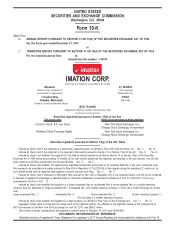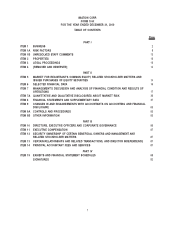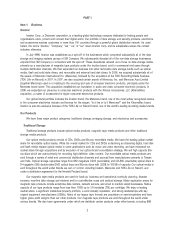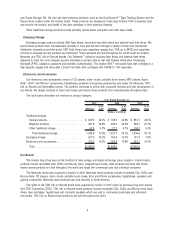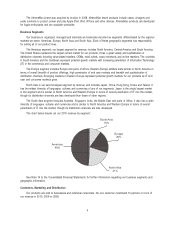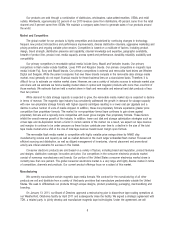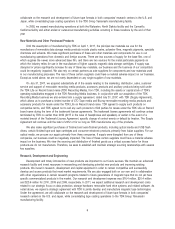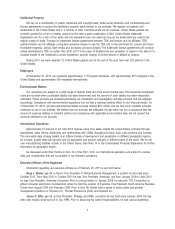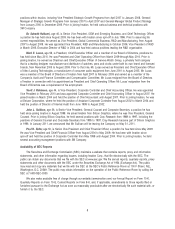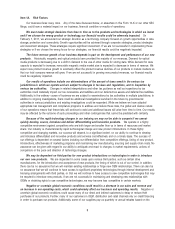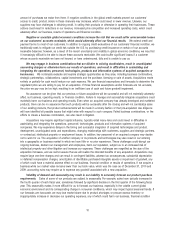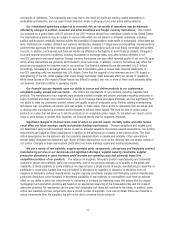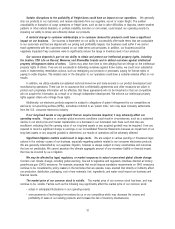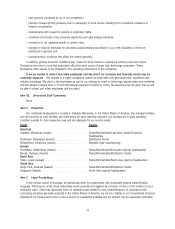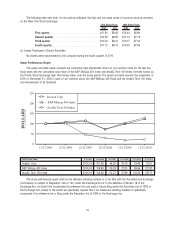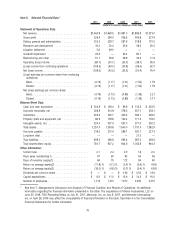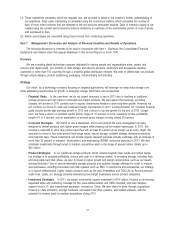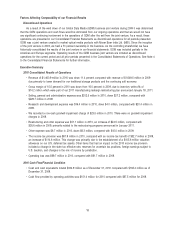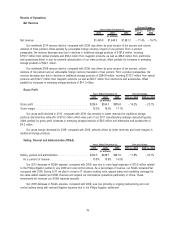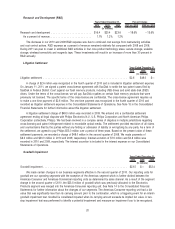Memorex 2010 Annual Report Download - page 13
Download and view the complete annual report
Please find page 13 of the 2010 Memorex annual report below. You can navigate through the pages in the report by either clicking on the pages listed below, or by using the keyword search tool below to find specific information within the annual report.amount of purchases we make from them. If negative conditions in the global credit markets prevent our customers’
access to credit, product orders in these channels may decrease, which could result in lower revenue. Likewise, our
suppliers may face challenges in obtaining credit, in selling their products or otherwise in operating their businesses. These
actions could result in reductions in our revenue, increased price competition and increased operating costs, which could
adversely affect our business, results of operations and financial condition.
Negative or uncertain global economic conditions increase the risk that we could suffer unrecoverable losses
on our customers’ accounts receivable, which would adversely affect our financial results. We extend credit and
payment terms to most of our customers. In addition to ongoing credit evaluations of our customers’ financial condition, we
traditionally seek to mitigate our credit risk outside the U.S. by purchasing credit insurance on certain of our accounts
receivable balances; however, as a result of the recent uncertainty and volatility in global economic conditions, we may find
it increasingly difficult to be able to insure these accounts receivable. We could suffer significant losses if a customer
whose accounts receivable we have not insured, or have underinsured, fails and is unable to pay us.
We may engage in business combinations that are dilutive to existing stockholders, result in unanticipated
accounting charges or otherwise harm our results of operations, and result in difficulties in assimilating and
integrating the operations, personnel, technologies, products and information systems of acquired companies or
businesses. We continually evaluate and explore strategic opportunities as they arise, including business combinations,
strategic partnerships, collaborations, capital investments and the purchase, licensing or sale of assets. Acquisitions made
entirely or partially for cash would reduce our cash reserves. We use financial assumptions and forecasts to determine the
negotiated price we are willing to pay for an acquisition. If those financial assumptions and/or forecasts are not accurate,
the price we pay may be too high, resulting in an inefficient use of cash and future goodwill impairment.
No assurance can be given that our previous or future acquisitions will be successful and will not materially adversely
affect our business, operating results, or financial condition. Failure to manage and successfully integrate acquisitions could
materially harm our business and operating results. Even when an acquired company has already developed and marketed
products, there can be no assurance that such products will be successful after the closing and will not cannibalize sales
of our existing products, that product enhancements will be made in a timely fashion or that pre-acquisition due diligence
will have identified all possible issues that might arise with respect to such company. Failed business combinations, or the
efforts to create a business combination, can also result in litigation.
Acquisitions may require significant capital infusions, typically entail many risks and could result in difficulties in
assimilating and integrating the operations, personnel, technologies, products and information systems of acquired
companies. We may experience delays in the timing and successful integration of acquired technologies and product
development, unanticipated costs and expenditures, changing relationships with customers, suppliers and strategic partners,
or contractual, intellectual property or employment issues. In addition, key personnel of an acquired company may decide
not to work for us. The acquisition of another company or its products and technologies may also result in our entering
into a geographic or business market in which we have little or no prior experience. These challenges could disrupt our
ongoing business, distract our management and employees, harm our reputation, subject us to an increased risk of
intellectual property and other litigation and increase our expenses. These challenges are magnified as the size of the
acquisition increases, and we cannot assure that we will realize the intended benefits of any acquisition. Acquisitions may
require large one-time charges and can result in contingent liabilities, adverse tax consequences, substantial depreciation
or deferred compensation charges, amortization of identifiable purchased intangible assets or impairment of goodwill, any
of which could have a material adverse effect on our business, financial condition or results of operations. If we acquire a
business while our market value remains lower than our book value, which was the case as of December 31, 2010 and
2009, accounting rules may require us to expense any goodwill associated with a new acquisition.
Volatility of demand and seasonality may result in our inability to accurately forecast our product purchase
requirements. Sales of some of our products are subject to seasonality. For example, sales have typically increased in
the fourth quarter of each fiscal year, sometimes followed by significant declines in the first quarter of the following fiscal
year. This seasonality makes it more difficult for us to forecast our business, especially in the volatile current global
economic environment and its corresponding change in consumer confidence, which may impact typical seasonal trends. If
our forecasts are inaccurate, we may lose market share due to product shortages or procure excess inventory or
inappropriately increase or decrease our operating expenses, any of which could harm our business, financial condition
10


